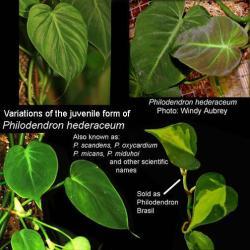When trying to find the ID of an aroid specimen most of us post a single photo since we believe a photo of the leaf should be adequate to learn the name of the species. That is often a myth.
Plants change shape as they grow and at least one out of every known plant species has multiple leaf forms or "faces" in the adult stage. During the ontogeny of a plant most go through many changes and as a result a species will be very different in the juvenile form than in the adult stages of its life. Ontogeny is the natural progressive changes in growth of any living being. Think about the way a child changes from birth to the time they become old, that is ontogeny.
To complicate the problem of finding a good ID you must also consider the natural variation in plant species. The blade of a plant is like the face of a human being. Humans have many different faces, different colors of our skin color, hair color, height, weight and other differences in our physical features. But there is only one species of humans, Homo sapiens. Just because our faces don't all look alike does not mean we are all different species and just because the leaf of a plant specimen does not look exactly alike one that is similar does not mean it is something else! Color has little to do with determining the species of a plant based solely on the color of a blade..
When you ask for a the identification of a plant you should post photos of the top and bottom of a leaf plus other parts of the plant including the petiole, stem and if at all possible aninflorescence.
Why? This article will hopefully make the reasons clear. If you've read this before, read it again. The article has been completely updated with many new photographic examples added:
http://www.exoticrainforest.co...

